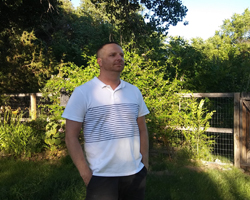Daniel Rowan: “Continuity of care will improve as we come to understand more clearly the people we are serving.”

WHO/Daniel Rowan
Inside prison, many people think that their life is on hold. I, however, refused to believe this while I was inside and instead actively sought things that would bring meaning and purpose. I discovered this fulfilment in the New Mexico Peer Education Project (NMPEP).
NMPEP trains groups of incarcerated men and women to become peer health educators. I joined this project and became an educator, gaining responsibilities to teach others about general health literacy, hygiene, sexually transmitted infections, tuberculosis, diabetes, skin infections, addiction and harm reduction. Over 50% of people entering prison in New Mexico test positive for hepatitis C, so education about this was particularly vital.
This health project provided me with much more than technical health knowledge. I also engaged with topics including adult learning theory and how to deal with speech anxiety. It gave me the opportunity to take responsibility for my own health and prepare to engage with community health in a positive and productive way.
But often there is a disconnect between prison and community health systems. Many people receive medical care regularly for the first time in prison, and after release it can be very difficult to find a doctor, get an appointment and then follow up with the doctor’s recommendations. It has become clear to me that continuing care upon release is critical not just to the individual’s health but also to the health of the community as a whole.
Although NMPEP includes training on well-being resources after release from prison (what to connect to and how to connect to it), release is still hard for many people. There is often no warm welcome home, and agencies and resources are always changing, making continuity of care very difficult.
Also, the significant disconnect between prison and community health systems leaves many gaps to fall through – in fact, in the first weeks after release, the risk of overdose is worryingly high. Depression and post-traumatic stress disorder are also very real risk factors. There must be ways to overcome a broken system.
When I was released from prison, I was able to take advantage of the changes in the United States’ health system that allowed me to receive emergency dental care. This showed me that there were ways to help others as a peer health educator outside prison, not just within. So, in 2015, I cofounded Best Chance with a dear friend of mine, Stanley Weinstein, to deal with this disconnect.
Best Chance is an organization that uses a peer-based model for men who are recently out of prison to provide them with a welcome home and link them with health resources. The peer model is particularly important – having support from those who have overcome the same struggle offers a tangible window of hope.
The organization is a warm environment to help people realize their own strengths and potential, regardless of any diagnosis. This not only attempts to fill the gap in continuity of care, but also attempts to minimize recidivism. Let’s face it, there are many programmes that are more about research and writing papers than impacting people’s lives. This programme gives people a voice in their own health and well-being.
One simple example of how Best Chance works for the incarcerated is the Learning Lunch every Tuesday. Men gather around a table to share food and personal experiences about re-entering society. One of the most powerful resources at Best Chance is the hope that is found in the stories that are shared. I have seen men who are unsure of themselves and the world around them discover hope simply by meeting a peer support worker who is healthy and happy.
Continuity of care will improve as we come to understand more clearly the people we are serving and give them the opportunity to speak for themselves. With hope of something better, continuity of care becomes a real and effective possibility.



